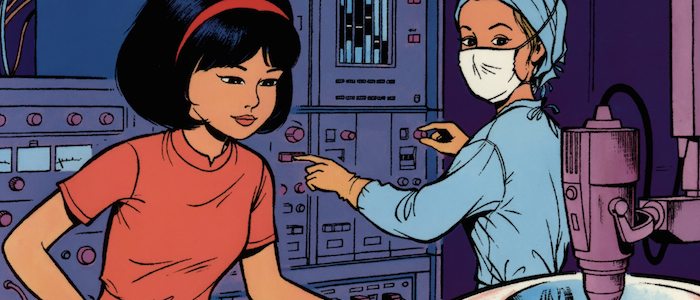Yoko Tsuno: On the Edge of Life
Roger Leloup (Writer and Artist)
Cinebook
August 16, 2007
There is something special about Franco-Belgian comics from the 1970s. The comics of Spirou Magazine, Tintin, and Pilote solidified the dominance of Franco-Belgian comics into the modern era. Large format, long-form narrative storytelling, complex characters, and clean, clear artistic styles are the hallmark of the Euro-style comics, and Yoko Tsuno is no exception. This intelligent and attractive young woman must use all her wits to solve her next mystery. Written and illustrated by Roger Leloup, who previously drew backgrounds for Herge’s iconic Adventures of Tintin, Yoko Tsuno won several awards, creating an iconic Nancy Drew character for the modern age.

In 1970s Europe, Yoko Tsuno, a Japanese electronic engineer, arrives in Rothenburg, Germany at the behest of her sick friend, Ingrid. She arrives to find her friend ill, but not the one who called for her. After meeting Ingrid’s cousin, Rudy, Yoko discovers he called on her to investigate the “vampires” stealing Ingrid’s blood. With help from her recurring friends, Vic and Pol, Yoko discovers that the mysterious night stalker isn’t a vampire at all, but a scientist attempting to test synthetic blood. But for the benefit of whom? The gang soon discovers that there is a young girl who survived a bombing in her town and needs synthetic blood to survive, using the most sophisticated tools in science and medicine to keep her alive in suspended animation decades later.
Yoko Tsuno and her cadre of friends are the epitome of the Scooby gang template. Yoko is the smartest member of her group. She’s an electronic engineer by day, and can use both her highly specialized education to identify an underground scientific compound and a tomb-penetrating camera to look at long-decomposed bodies. When there is a creak outside a crypt door, Yoko grabs a flower pot and investigates; when a recorder is discovered, putting the life of a young girl in danger, she breaks it with a rock and is injured along the way, illustrating her deep loyalty to her friends. And no matter what happens, Yoko always gets back up, always takes on new problems, always learns something new. While aspects of the story are on the verge of being classified as science fiction, many of the technologies used in the comic are analogous to modern medical technologies. She is the role model I wish I had in my young years: a strong, confident woman who makes her decisions for herself and has conviction to spare.

Readers may take issue with the problematic themes in the stories from the Franco-Belgian mid-century era of comics, particularly in respect to the representation of minority characters. This can be seen in Herge’s representation of Africans in Tintin, using holdover imagery from the French colonial era. Yoko Tsuno gives the feeling of being very progressive about the characters in this story. Yoko is often noted as being Japanese; however, stereotypes of Japanese women have very little impact on her story arc: most of her actions focus on her deductive reasoning and technological knowledge. This was an era of powerful women in European comics. Barbarella had debuted a decade earlier, and that foundation built on the sexual revolution of the 1960s to give a starting point for intelligent, well-spoken female characters of the 1970s. If you want a fun adventure story, Yoko Tsuno is a quick mystery read sprinkled with science fiction elements.

